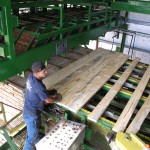Why Exporting Lumber Takes More Than Just Shipping Containers

Molly Messick / StateImpact Idaho
Idaho Forest Group's Mike Henley tells buyer Koji Fujiwara and consultant Paul Owen how the company sorts timber for the Japanese market.
When the recession hit, it hit Idaho’s forest products industry hard. For years, the U.S. housing market had been strong enough that lumber producers had little trouble finding buyers. But by 2009, housing starts stood at a fraction of what they had been just four years earlier. Anxious for sales, lumber producers looked to foreign markets. As StateImpact reported last week, the Japanese market has kept one North Idaho mill up and running.
That story focused on fundamental differences between the U.S. and Japanese housing markets, many of which relate to the Japanese market’s focus on quality. What that story didn’t get at is the challenges of producing lumber for an entirely new market; one that has a different set of aesthetic demands and standard measurements.
“There’s defects in lumber that are seen to be acceptable at Lowe’s, Home Depot that you wouldn’t even think about putting it on a boat and sending it to Japan,” explains Steve Spletstoser, quality control manager in Idaho Forest Group’s Laclede mill.
Producing lumber for a more stringent set of quality demands, along with shifting to metric units, involves a lot of problem-solving in a mill engineered to produce great quantities of lumber for U.S. standards.
“It turned us upside down, because you’re not in the same business,” says Spletstoser. “You’re making an entirely different product. There’s entirely different challenges. We had to learn how to make 4-meter lumber. We had to modify equipment to do that.”
Idaho Forest Group treats a lot of the specifics of just how this works as proprietary information. Export sales manager Ahren Spilker says it only makes sense to be cautious, even though the company doesn’t believe many lumber producers would be able to replicate their process in order to serve the Japanese market.
“The whole reason we’re letting you do the interview is that we’re not real concerned about the generalization of exports for what we’re doing, because it’s a really difficult product to make for most mills,” Spilker explained during a tour of a sawmill just north of Coeur d’Alene.
“We’ve gotten it down to where we can do it effectively and with margin, but domestic producers as a whole don’t know how to do this. It’s very difficult for them to understand a) the conversions b) how to source the logs and how to set up the breakdowns for the sawmill.”
In other words, the Laclede mill’s preservation — the focus of last week’s story — isn’t simply a matter of finding a few Japanese clients and lining up shipping containers. It has involved a lot of technical adjustments, a lot of time and attention. That’s one reason Spilker believes Idaho Forest Products will retain its focus on exporting to Japan, even as U.S. lumber demand begins to turn upward.


